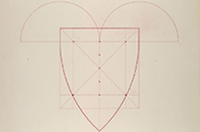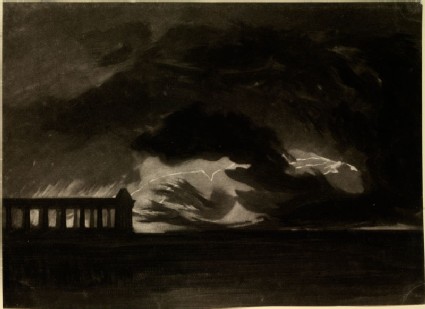Ruskin's Rudimentary series, 3rd ed. (1872)
Items marked 'M' are drawings "by my own Hand" (by Ruskin), P are photographs, E engravings and A by Ruskin's Assistant, Arthur Burgess.

Ruskin's Catalogues: 1 object
Show search help- Reference URL
Actions
Pæstum (Plate from the "Little Liber Studiorum") Turner
-
Ruskin text
R|171} Pæstum. Engraved by Turner. -
Details
- Artist/maker
-
Turner (Joseph Mallord William Turner) (1775 - 1851) (designer, engraver)
- Object type
- Material and technique
- mezzotint on paper
- Dimensions
- 156 x 217 mm (sheet)
- Inscription
- Verso:
near bottom left, in ink: Mary Constance Clarke [Lugt 449]
immediately to the left, in graphite (recent): = L 449
bottom right, a stamp in black ink depicting a tower in a double oval frame [Lugt 2758, Charles Stokes]
just below and to the right, in graphite (recent): =L.2758
bottom, right of centre, in graphite: R.799(a)
- Provenance
-
Charles Stokes, presumably until his death in 1853
- No. of items
- 1
- Accession no.
- WA.RS.RUD.171
-
Subject terms allocated by curators:
Subjects
-
References in which this object is cited include:
References
Ruskin, John, The Ruskin Art Collection at Oxford: Catalogue of the Rudimentary Series, in the Arrangement of 1873, ed. Robert Hewison (London: Lion and Unicorn Press, 1984), cat. Rudimentary no. 171, RUD.171
Rawlinson, W. G., The Engraved Work of J. M. W. Turner, 2 (London: Macmillan, 1908-1913), no. 799
Ruskin, John, Instructions in Practice of Elementary Drawing, Arranged with Reference to the First Series of Examples in the Drawings Schools of the University of Oxford (n.p., [1872]), cat. Rudimentary no. 171
Ruskin, John, Instructions in the Preliminary Exercises Arranged for the Lower Drawing-School (London: Smith, Elder, 1872), cat. Rudimentary no. 171
Ruskin, John, Instructions in the Preliminary Exercise Arranged For the Lower Drawing-School (London: Spottiswoode, 1873), cat. Rudimentary no. 171
Ruskin, John, ‘Rudimentary Series 1878’, 1878, Oxford, Oxford University Archives, cat. Rudimentary no. 171
Ruskin, John, ‘The Ruskin Art Collection at Oxford: Catalogues, Notes and Instructions’, Edward T. Cook and Alexander Wedderburn, eds, The Works of John Ruskin: Library Edition, 39 (London: George Allen, 1903-1912), 21, cat. Rudimentary no. 171
Location
-
- Western Art Print Room
Position in Ruskin’s Collection
Ruskin's Catalogues
-
Ruskin's revision to the Rudimentary series (1878)
remains 171. PæstumA collection of the Liber Studorium would be incomplete without showing the way in which Turner practised on the copper to learn the business of Mezzotint engraving. Technically, this example ought to have begun the series, but the sublimity of its subject induces me to place it as the real Preface to his heroic design, and, I think, justifies me in doing so. The student will remember that in the Frontispiece the Classical Architecture is represented as fallen, but the Norman standing, meaning that the faith in which alone true architecture can be built had perished with the nations who held it in Greece and Italy, but was yet living in England and Normandy. His symbol of the destruction of a religious Faith is always storm and the lightning of Heaven. Thus, in his great drawing of Stone-Henge the fall of the Druidical Religion is indicated by the lightning totaltotal lightning striking one of the stones, while the shepherd flies with his scattered flock; but in the drawing of Salisbury seen from Old Sarum, (lent at present and placed in the Reference Series for comparison,) the storm is only partial, the shepherd stands erect still watching his flock, and the spire of the Christian cathedral rises in full light amid soft rain: while here, above the ruined temples of Pæstum, the fires R. of heaven blaze like a volcano, the clouds of its anger fly like angels of Ruin, and the skeleton of the shepherd lies in the ground: - it is seen in the completed plate only, the example here under consideration being the first sketch upon the metal.





